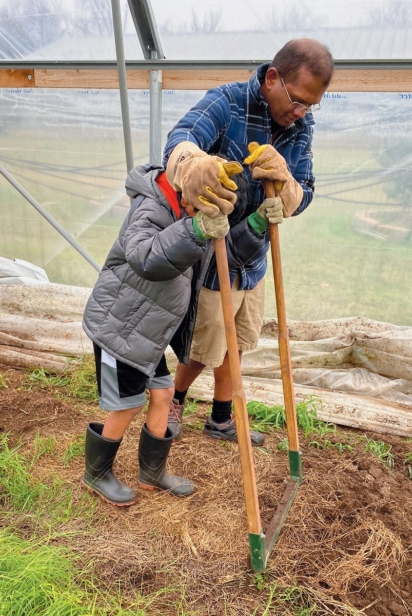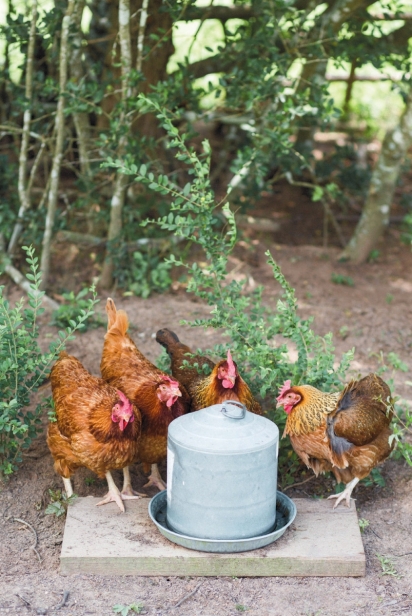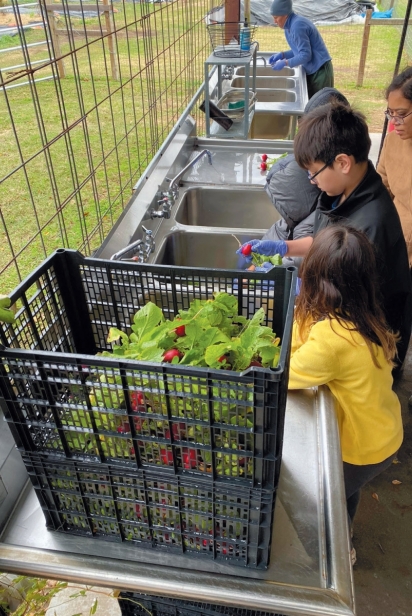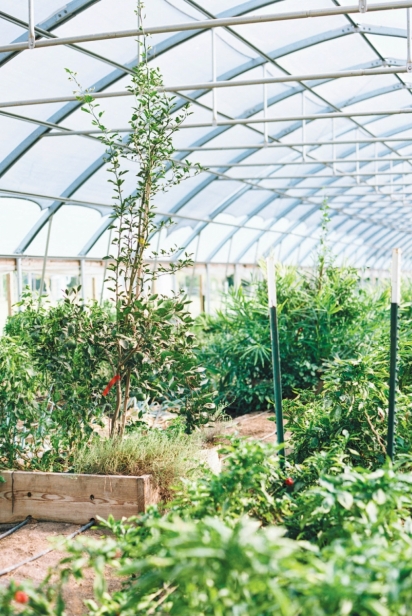Blackwood Land Institute Cultivates Healthier Produce, People, Planet
Learning is hands-on at Blackwood Educational Land Institute
On the backside of Blackwood, the nonprofit teaching farm outside of Hempstead, Texas, the last 10 acres of undeveloped land tower with tall trees as Cath Conlon’s grey eyes survey the soil below. To her, this dense forest floor is more of a table of future edible foods than an obstacle to further development. Instead of a track hoe, goats will clear the way for berries and a carpet of nitrogen-fixing dichondra ground cover to be planted into what she hopes will become a living edible forest.
Cath sees plants much like she sees children, meant to grow from year to year into full adults, and she sees opportunity in teaching soil science to the next generation. In the coming years, the Blackwood Educational Land Institute hopes to grow in modeling and testing how nature develops its own nutritionally dense soil and root systems to support the most sustainable food production system possible.
“We never let the soil do for us what it can in terms of nutrient density in the food,” says Cath, describing how important plant nutrition and soil health are in evaluating any farming practice.
The Blackwood Educational Land Institute models the indispensable restorative food systems in our lives to children in the Houston area, and has been doing so for over 30 years. Its founder found her inspiration to innovate from within—a vision she saw long before she found peers to collaborate with. As Cath searched for support and inspiration, she found it in places like New York’s Stone Barn Center for Food and Agriculture, and the Land Institute in Kansas. Today, the Blackwood farm covers 33 acres and provides fresh, local food to area residents through its community-supported agriculture (CSA) subscription program.
For Cath, the future of farming is perennial rather than annual crops, and though our global food system and agricultural practice isn’t focused in that direction, food forests and perennial row crops are where she spends her thoughts. If aviation took 50 years to develop from idea to everyday use, she said, so will the development of perennial varieties and new farming practices to fit them.
Touring the farm, I’m taken past a wash house, two acres of cultivated fields, a commercial kitchen and gathering hall, dormitory facility, chicken houses and into this, the farthest section of the property. Cath is telling the origin story. What was started as a transformational relationship that changed her family’s trajectory has now transformed teachers, schools and hundreds of students.
Today her grown son, Cade, chef and owner of Long Spoon Catering company, is the first fruit of her vision. Blackwood grew out of a decision to open up the family land to his school group so that he could spend more time out in nature as he grew, something Cath holds in her childhood memories as transformative. Throughout his childhood Cade’s school would send groups out to the farm to work on Fridays, learning about food in nature. When Cath was ready to do more, she gathered a team to help support and direct her next phase of the vision. They agreed it needed to be beautiful, a place where people want to sit for hours and have a conversation. As she describes her dreams of building a place to gather people back to working the land, Cath looks out across beds she’s cultivated since the very beginning and where she has taken thousands of students to taste and identify, often for the first time, herbs and medicinal plants. It’s a living classroom she thrives in, this picture-perfect backyard garden view. Surrounded by land made up of Savannah Post Oak, Blackland Prairie and Piney Woods, Baleyfield House spans three decades of informing the next generation in restorative agricultural practice, inspiring a new wave of farmers and ecologists to solve our food problems.
She built the house in 1996, a 5,000-square-foot straw-bale house equipped with a rainwater harvesting system, kitchen and living space that houses 38 teachers and students. The house and layout of gardens surrounding it were her answer to her critic’s advice to make it beautiful. They teach several camps a summer here, employing 29 camp counselors last summer, offering them an intensive wilderness first aid training course at the beginning of the summer every other year. The students and teachers have been calling it home, some for over 25 years, and say working this farm is so much more than a backyard school garden.
About 30 different schools and homeschool groups from the Houston area have been coming out for day trips or multi-night trips throughout the school year with week-long camp groups each summer. Teachers can go online and customize the visit to fit their classroom age, group size and interests. Students learn how to think through observing nature and how the soil interacts with plants and animals. They learn how to make and apply compost tea as a fertilizer.
With researchers from the Land Institute looking at ways to reduce the number of times tractors have to drive over a crop per season, the first perennial cross of wheatgrass, Kernza, has been developed and is being tested along with other perennial legumes and oil seeds. Of course current annual crops won’t be replaced unless developing staple perennials are able to outproduce their counterpart, but Cath plans to plant Kernza and participate in testing the crop at Blackwood.
She’s also partnering with David Ramjohn, a scientist who studies nutrition in foods that are planted with algae. Cath plans to test the nutritional content of the food planted to see which method produces the best result. “I think that’s what we need,” she said, more field nutritional testing. And more connection to where the food comes from, she adds. She wants to see more of their CSA families actually coming out to the farm to pick up their boxes, she said.
“That’s what our goal is. It goes back to, ‘Where did it come from?’” So families can come out together, pick up their box but also learn something or make something while they’re here, “so that the kids learn and may want to become a farmer, nutritionist or a better mother.” It’s the connection to the people that makes it important, “that human component of growing food and of land somehow just gets lost.”
A CLOSER LOOK
Amy Milliron, farm director at Blackwood, easily pushes the tines of a broadfork into the earth with her body weight. For her 5-year-old student, it’s not so easy. Mom and baby sister step up and help out, all three pushing weight on the four-foot fork to plunge it into the earth. The implement, used to manually break up the soil to improve aeration, is used in low-tilling cultivation methods, which are less destructive to the soil’s surface. It’s best, she believes, to let nature do its thing slowly rather than speed up the process by running a plow behind a tractor. It’s also best to let the next generation in on the process, taking them through the steps of where food comes from and the hard work it takes to make food. Already growing in this covered greenhouse tunnel are moringa trees, nopal cactus, lemons, limes, chile pequin and dragon fruit.
“We want to get some perennial cut flowers in here because that would help the pollinators,” said Amy, but “this will be primarily an edible perennial tunnel.” Blackwood started with mostly annuals and is now in the process of shifting to a more perennial system. “We’ll still always grow some annuals because that’s what people recognize when they eat,” said Amy. “If we don’t put things they recognize in the CSA box, they won’t buy it. We put nopal cactus in the box and we put in moringa powder and people go, ‘What is this?’ We give them ideas and they try something new and they say ‘I didn’t even know this existed.’”
The moringa tree, native to South Asia and now a stylish superfood plant, is hailed to have higher protein content than yogurt, more vitamin C than an orange and more iron than spinach—and it grows really, really fast in a humid Southern climate. Nopal cactus, native to Mexico and the Southwest, can be boiled like okra with a slimy texture, or sautéed with a slight citrus taste. It’s known for its anti-inflammatory properties and for lowering blood sugar and cholesterol.
Blackwood’s CSA box program is in the process of implementing the new Good Agriculture Practice rules (food safety rules that ensure fruits and vegetables are produced, packed, handled, and stored as safely as possible), though the program is not large enough to be required to be GAP certified yet. The first time these students came they were in the farm kitchen with Chef Cade, learning about where food comes from and making their own fresh pasta. Today, they’re clearing a row of soil for perennial plants with broadforks and learning how to pick, wash and package crops for the CSA using the new GAP standards. The week before, School of the Woods, a Montessori school in Houston, had 43 students stay overnight for a three-day teaching workshop, Amy said.
Bent over a row of radishes with her seventh-grade son and crate nearby, Melissa Endicott, started sharing recipes of roasted radishes with the work group, how she roasted them for Meadow Wood Elementary students to taste as a school garden parent volunteer. “I was surprised they would eat it at all,” she said. Though that was a few years ago, she said, the students and teachers still talk about it and want her to come back.
Over in the wash house, Amy has the kids wheel out dry racks and hose off their crates full of radishes before taking them to the sterilization sinks for sanitation. Their small bodies can’t lift the weight of the racks, but they think they do as staff helps support them in the lifting. It’s windy and 50° and thoughts are turning toward hot chocolate. But kids and water nearly always find a way to pair up with giggles regardless of the weather. They happily plunge several crates of red orbs into icy water until the job is done.
Then they’re told how to count and bunch them to take home. Everybody stops to taste test. Crunch, crunch. “Tastes like a carrot,” says one. I bite down and think how long it’s been since I bought a radish; how easy it is to grow them; how I used to keep a small garden.
The cold cuts the day a little shorter than usual and the crowd picks hot chocolate on the drive home over staying for a picnic lunch on site. So I grab my bunch, wave goodbye and drive off with radishes to roast for dinner.
For more information about tours, workshops, CSAs and other offerings at the farm, visit blackwoodland.org.









